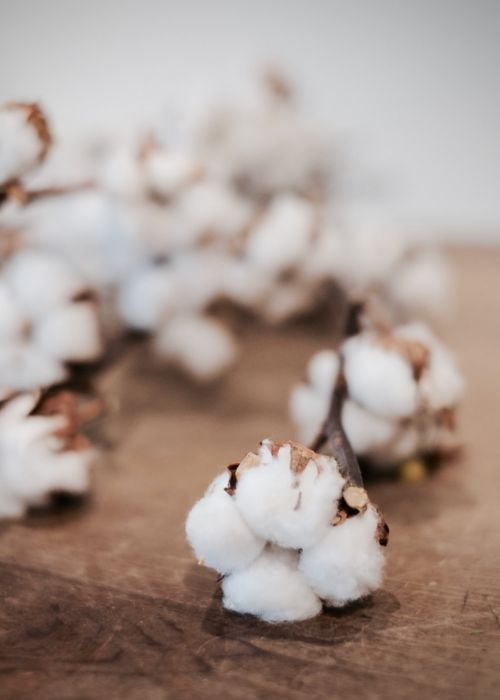ORGANIC COTTON vs. CONVENTIONAL COTTON: WHAT'S THE REAL DIFFERENCE?

Cotton is one of the most prevalent natural fibers in the world, and we use it to produce everything from clothing and bedding to personal products. Cotton is not all the same, though. The more concerned people are about what they put on their skin and how it's made, the more we hear about organic cotton vs. conventional cotton.
Cotton is the natural, safe option at first glance. Yet the cultivation and processing of cotton greatly determine cotton's health and environmental impacts. From water to chemical pesticides, there are several main disparities between organic and non-organic cotton beyond the title.
Here, we'll debunk what constitutes cotton as "organic," contrast it with conventional cotton cultivation, and tell you why you should choose certified organic cotton—for your skin, the planet, and the farmers who cultivate it.
Understanding Organic Cotton and Conventional Cotton :
Definition of Organic Cotton and Its Certification Requirements
Organic cotton is grown using methods that prioritize environmental health and biodiversity. Unlike conventional cotton farming, organic practices avoid synthetic pesticides, toxic chemicals, and genetically modified seeds. Instead, organic farmers rely on natural methods like crop rotation, composting, and the use of beneficial insects to manage pests.
For cotton to be considered organic, it must meet strict standards throughout its life cycle—from the way the cotton plant is grown to how the fibers are processed.
Key certifications to look for include:
- GOTS (Global Organic Textile Standard) – Ensures the cotton is organically grown and processed with low-impact methods.
- OEKO-TEX Standard 100 – Tests for harmful substances in the finished textile.
- USDA Organic – Certifies organic farming practices in the United States.
- Textile Exchange Organic Content Standard (OCS) – Verifies the presence of organic material in products.
These certifications confirm that the cotton has not only been grown without harmful chemicals, but also processed in ways that are safer for both the environment and the end user.
Conventional Cotton Production and Its Common Practices
Conventional cotton, also referred to at times as non-organic cotton, is the most common in the world. While it is yield-efficient, it is at the expense of a huge environmental cost. It is often described as the "dirtiest crop" since it utilizes huge amounts of chemical pesticides, insecticides, and artificial fertilizers—most of which are classified as toxic to the environment and human health.
Some of the prominent characteristics of conventional cotton farming include:
- Use of genetically modified seeds to ensure pest resistance and increased production
- Excessive use of irrigation, draining natural resources like water
- Excessive use of toxic chemicals that can potentially poison water and soil systems
- Exposure of farmers and local communities to toxic chemicals
Compared to certified organic cotton, conventional cotton has fewer sustainability checks during production, and as a result, it is harder to trace and guarantee ethical practices.
Being aware of these fundamental differences matters if you wish to make healthier and more sustainable choices when shopping for clothes, cotton sheets, or other textiles.
Key Differences Between Organic Cotton and Conventional Cotton
Use of Pesticides and Fertilizers
One of the most significant distinctions in the organic cotton vs conventional cotton debate lies in how each crop is grown. Conventional cotton farming uses large quantities of synthetic pesticides, chemical fertilizers, and genetically modified seeds to boost yield and reduce pest damage. In fact, cotton accounts for roughly 16% of the world’s insecticide use despite covering only 2.5% of global farmland—earning it the label of one of the “dirtiest crops” in agriculture.
In contrast, organic cotton production relies on natural methods like:
- Crop rotation to maintain healthy soil
- Compost and organic manure instead of chemical fertilizers
- Beneficial insects and non-toxic solutions for pest control
- A ban on genetically modified organisms (GMOs)
This approach reduces pollution, protects biodiversity, and improves soil fertility over time—making certified organic cotton a far more sustainable alternative.
Water Consumption and Environmental Impact
Water consumption is another important factor. In temperate regions, cotton is almost always grown using mechanized methods, which draw on water resources and affect local ecosystems. Pesticide and fertilizer residues also contaminate waterways, often worsened by local agricultural practices.
Organic farming, on the other hand, relies mainly on growing crops in areas with abundant rainfall and strives to create soil that is able to retain more water. According to the estimates published by Textile Exchange, organic cotton uses almost 91 percent less water than its non-organic counterpart. Thus, organic cotton becomes the choice for anyone looking at climate change, water shortage, and long-term environmental protection.
Fabric Quality, Softness, and Durability
When comparing organic cotton vs cotton from a consumer standpoint, fabric quality also matters. While both types of cotton come from the same cotton plant, how the fiber is grown and processed affects the final product.
- Organic cotton fibers are typically handpicked, which keeps them longer and more intact, resulting in softer, stronger, and more breathable fabrics.
- Conventional cotton, often machine-harvested, can suffer from fiber breakage, which may affect the softness and longevity of the material.
Many consumers find that organic cotton garments, such as cotton sheets or clothing, feel better on the skin—especially for those with skin allergies or sensitivities to harmful chemicals often found in non-organic cotton textiles.
Why Choose Organic Cotton?
Health Benefits: Fewer Allergens and Chemical Residues
As caring parents, we want only the best for our babies. Certified organic cotton does not contain toxic chemicals, synthetic pesticides, or bleach and is, therefore, a healthier option for eczema sufferers, people with sensitive skin, as well as babies. Skin allergies are not a problem with certified organic cotton since it has no potential chemical residue, including pesticides or formaldehyde-based treatments, which non-organic cotton has.
Cotton relies on the perception that it is natural and healthier. While that is the general perception, it is inaccurate since most of the available market cotton is not organic but rather, cultivated through chemical means and genetically modified seeds.
Wearing clothing or using hygiene products containing organic cotton fibers limits health risks. This is particularly important for babies, those who have weakened immune systems, or individuals with hypersensitivity to chemical compounds.
Ethical and Sustainable Production Practices
Choosing organic cotton supports sustainable alternatives to one of the most chemically intensive crops in the world. Organic farming practices are designed to regenerate the soil, conserve water, and reduce pollution, contributing to a healthier environment and a lower carbon footprint.
Key sustainability benefits include:
- No genetically modified seeds
- Lower greenhouse gas emissions
- Minimal water pollution
- Improved biodiversity and soil health
Additionally, organic cotton certification systems like GOTS ensure not only environmental care but also compliance with social criteria, including safe working conditions and fair wages.
Impact on Farmers and Communities
Organic cotton growers work in safer conditions. They're not exposed to toxic chemicals or harmful insecticides that are common in conventional cotton farming. This reduces the risk of pesticide-related illnesses and promotes better long-term health for farming families.
Economically, organic farming can offer better stability. It encourages local, small-scale production and often leads to stronger community development through fair trade programs and access to organic premiums. These systems help break the cycle of debt caused by the dependence on expensive chemical inputs in non-organic cotton farming.
Is All Cotton Organic?
Clarifying the Confusion Surrounding "Natural" Cotton
Certifying bodies issue strict environmental policies on health. That means only certified organic cotton consequences legal regulations stands as proof that sets them apart from “natural” cotton. It is important to note that these organic policies are not met by “natural” cotton, thus further enforcing scrutiny on the policies constraining every “natural” cotton out there.
Organic cotton labeled 'natural' is likely to contain harmful chemicals and, as such, is not subjected to health standards, unlike its organic counterpart.
The Contribution of the Better Cotton Initiative concerning Organic Certification
The BCI promotes improving the methods of farming cotton within the Better Cotton Initiative (BCI) but does not meet the requirements for organic cotton certification. Even while BCI promotes better sustainable practices than conventional cotton farming, they still use synthetic herbicides and genetically modified organisms.
BCI’s attempts to improve cotton farming are noteworthy, although GOTS guarantees that the cotton is obtained from organic farming without pesticides, herbicides, and other toxic chemicals. So, while BCI makes some improvements to the sustainability of cotton production, it fails to meet the standards of true organic certification.
How to Identify and Buy Genuine Organic Cotton
Certifications to Look For (GOTS, OEKO-TEX, etc.)
To ensure you're getting genuine organic cotton, look for third-party certifications on product labels. These include:
- GOTS (Global Organic Textile Standard) – Verifies both organic cotton production and responsible processing
- OEKO-TEX Standard 100 – Ensures the finished textile is free from harmful substances
- Textile Exchange’s OCS (Organic Content Standard) – Confirms the presence of organic cotton fibers
Tips for Checking Product Labels and Sustainable Brands
When shopping for organic cotton clothing, cotton sheets, or other textiles, keep these tips in mind:
- Check for clear certification logos like GOTS or OEKO-TEX
- Avoid vague terms like “natural cotton” without proof of certification
- Research sustainable brands that are transparent about sourcing
- Look for mentions of organic cotton growers, crop rotation, or eco-friendly practices
By being label-savvy, you can support brands committed to organic cotton vs conventional cotton standards and reduce your impact on the environment.
FAQ:
Is organic cotton better than normal cotton?
If you are trying to determine the difference between organic cotton and normal cotton, cotton is an essential part of the cloth fabric. Organic cotton is grown without the use of poisonous chemicals, fertilizers, or pesticides and is better for the environment than normal cotton. Studies have indicated that using organic cotton also helps in reducing cancer rates.
How is Non-Organic Cotton different from organic cotton?
Non-organic cotton is grown using synthetic pesticides, fertilizers, and genetically modified seeds. In contrast, organic cotton is produced without these chemicals and follows strict environmental and health standards. While some consider Better Cotton an improvement over conventional cotton due to its focus on sustainability and farmer welfare, it does not meet the same strict standards as organic cotton. Each type has different practices and goals, making their impact and benefits distinct.
Is it safe to wear pure cotton?
Cotton comes in various forms, including organic and non-organic types. Non-organic cotton is often treated with pesticides that can leave harmful residues. While both types are comfortable to wear, people with sensitive skin may experience allergic reactions to non-organic cotton. In the long run, organic cotton is a safer choice, as it reduces exposure to toxic chemicals.
Is it important to buy organic cotton?
If you care to reduce your carbon footprint and avoid contact with noxious chemicals, then yes, it does make a difference. Organic cotton over otherwise grown cotton using chemical inputs favors sustainable agriculture, better working lives for cotton producers, and safer environments. Organic cotton fabrics last longer and are softer on your skin, so they represent better value over the long haul.
Conclusion
In conclusion, the choice between organic cotton and conventional cotton extends beyond personal health and environmental impact; it reflects a broader commitment to sustainability and ethical practices. Brands like L’Envers exemplify the transformative power of organic cotton in fashion. By prioritizing high-quality, GOTS-certified organic cotton, L’Envers crafts timeless knitwear that is gentle on sensitive skin and durable enough to last for years.
Choosing organic cotton products from brands like L’Envers not only aligns with eco-conscious values but also contributes to a healthier planet and more equitable industry practices.
FREE SHIPPING
from 300€ to Europe, from 320€ to North America, UK, Swiss, from 360€ to Asia
FLEXIBLE EXCHANGE AND RETURNS
within 30 days
3-PART PAYMENTS
with SplitIt
CUSTOMER SERVICE
Contact Us for advice and customization


